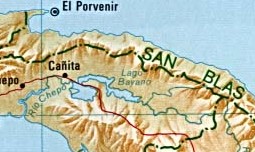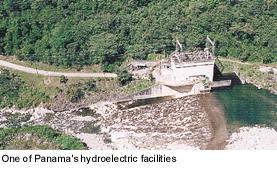 |
The Bayano Hydroelectric Dam in Panama
new! Kuna demand indemnification for the building of the hydroelectric dam (29/10/2007)
http://www.dams.org/kbase/consultations/latin/abs_p3_en.htm#huertas
Bayano Hydroelectric Project (30/8/2002)
Hector Huertas & Bonerge Pacheco
Interamerican Association for Environmental Defense (AIDA)
PANAMA
 Construction of the Bayano Dam in Panama in the 1970s flooded more than 350 km2 of pristine and highly biodiverse tropical forest, and forced the relocation of 2,000 Kuna and 500 Embera indigenous people from their traditional territories. Because access roads to the dam site were constructed, the area was opened to colonization by outsiders.
Construction of the Bayano Dam in Panama in the 1970s flooded more than 350 km2 of pristine and highly biodiverse tropical forest, and forced the relocation of 2,000 Kuna and 500 Embera indigenous people from their traditional territories. Because access roads to the dam site were constructed, the area was opened to colonization by outsiders.
Although the World Bank provided most of the capital for the Bayano dam ($42 million), the Bank did nothing to guarantee that the affected indigenous peoples would be appropriately resettled or that their rights would be protected. Consultation and participatory decision making processes were woefully inadequate.
The territories on which the Kuna and Embera were resettled were far less fertile and productive than the valuable ecosystems in which they lived prior to the creation of the reservoir. Environmental degradation since construction of the dam has further reduced the value of these lands.
The Panamanian government has systematically violated both the agreements made with the affected indigenous people at the time of construction and those negotiated since that time. Among the violations are the failure by Panama to provide the Embera and Kuna with adequate compensation for their traditional territories and legal title to the new lands.
Because the Embera and Kuna do not have legal title to their current territories, they have not been able to protect the area from invading colonizers. Though a bank and government project opened the region to colonizers, neither entity took action to prevent the entry of settlers.
The colonizers destroyed the environment and ecosystems of the Embera and Kuna territories through activities such as uncontrolled deforestation, hunting, and other resource extraction. This, in turn, caused a notable decrease in biodiversity and productive capacity of the lands. The trend continues to date as outsiders continue to enter the Bayano region.
The poorly executed forced relocation of the Kuna and Embera peoples has caused three decades of land disputes and violence in the Bayano river region. The disputes have led to deaths and injuries, and remain unresolved.
The project damaged the region's water resources. Submerged trees and vegetation caused eutrophication of the reservoir, impacting fish populations and making the water unsuitable for human use, while uncontrolled proliferation of aquatic vegetation spurred chemical spraying of the area. Disease vectors proliferated due to standing water.
Three decades after the forced relocation, the Embera and Kuna of the Bayano region live a marginal existence in that they often lack adequate food, water, and income. Their quality of life is much reduced compared to that before construction of the dam. The survival of the culture and traditional life of the Kuna and Embera is threatened. Construction of the Bayano dam was proposed by USAID, financed by the World Bank, and executed by the government of Panama. Because the project was carried out without adequate prior social and environmental assessments, it caused grave environmental and social harm. The Bank, the government of Panama, and USAID share the responsibility for these problems, and all three should take action to insure that these are resolved in the near future.